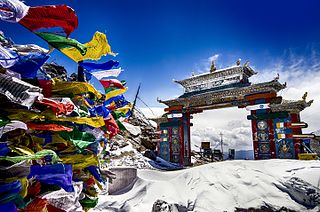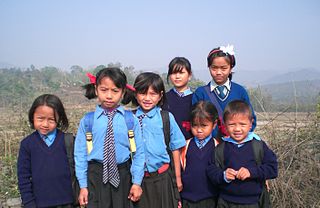Related Research Articles

Tripura is a state in northeastern India. The third-smallest state in the country,it covers 10,491 km2 (4,051 sq mi);and the seventh-least populous state with a population of 3.67 million. It is bordered by Assam and Mizoram to the east and by Bangladesh to the north,south and west. Tripura is divided into 8 districts and 23 sub-divisions,where Agartala is the capital and the largest city in the state. Tripura has 19 different tribal communities with a majority Bengali population. Bengali,English and Kokborok are the state's official languages.

Manipur is a state in northeast India,with the city of Imphal as its capital. It is bounded by the Indian states of Nagaland to the north,Mizoram to the south and Assam to the west. It also borders two regions of Myanmar,Sagaing Region to the east and Chin State to the south. The state covers an area of 22,327 km2 (8,621 sq mi). The official and most widely spoken language is the Meitei language. Native to the Meitei people,it is also used as a lingua franca by smaller communities,who speak a variety of other Tibeto-Burman languages. Manipur has been at the crossroads of Asian economic and cultural exchange for more than 2,500 years. This exchange connects the Indian subcontinent and Central Asia to Southeast Asia,East Asia,Siberia,regions in the Arctic,Micronesia and Polynesia enabling migration of people,cultures and religions.
Events in the year 1949 in India.

Meitei also known as Manipuri,is a Tibeto-Burman language of northeast India. It is the official language and the lingua franca of Manipur and an additional official language in four districts of Assam. It is one of the constitutionally scheduled official languages of the Indian Republic. Meitei is the most widely-spoken Tibeto-Burman language of India and the third most widely spoken language of northeast India after Assamese and Bengali. There are 1.76 million Meitei native speakers in India according to the 2011 census,1.52 million of whom are found in the state of Manipur,where they represent the majority of its population. There are smaller communities in neighbouring Indian states,such as Assam (168,000),Tripura (24,000),Nagaland (9,500),and elsewhere in the country (37,500). The language is also spoken by smaller groups in neighbouring Myanmar and Bangladesh.

Northeast India,officially the North Eastern Region (NER),is the easternmost region of India representing both a geographic and political administrative division of the country. It comprises eight states—Arunachal Pradesh,Assam,Manipur,Meghalaya,Mizoram,Nagaland and Tripura,and the "brother" state of Sikkim.

The Meitei people,also known as Meetei,Manipuri people,is an ethnic group native to Manipur. They form the largest and dominant ethnic group of Manipur in Northeast India. They speak the Meitei language,one of the 22 official languages of the Republic of India and the sole official language of Government of Manipur. The Meiteis primarily settled in the Imphal Valley region in modern-day Manipur,though a sizeable population has settled in the other Indian states of Assam,Tripura,Nagaland,Meghalaya,and Mizoram. There is also a notable presence of Meitei people in the neighbouring countries of Myanmar and Bangladesh. The Meitei ethnic group represents about 53% of Manipur's population.

Amra Bangali is a political party in India,based on the socio-economic and political philosophy Progressive Utilization Theory given by Prabhat Ranjan Sarkar;the party was sparked off in reaction against anti-Bengali rhetoric in Northeast India. Amra Bangali enjoyed a short stint in the spotlight in the mid-1980s when it even won some gram panchayat seats in border districts. Today,AMB is involved in various movements and protests including those against the Darjeeling Gorkhas calling for the creation of new state of Gorkhaland. It protested National Register of Citizens for Assam and Citizenship (Amendment) Act,2019.

The Chakma people or Changhma people,are an ethnic group from the eastern-most regions of the Indian subcontinent and Western Myanmar. They are the largest ethnic group of the Chittagong Hill Tracts region of southeastern Bangladesh,and the largest in the Chakma Autonomous District Council of Mizoram,India. Significant Chakma populations are found in the northeast Indian states of Arunachal Pradesh,Tripura and Assam.

The Insurgency in Northeast India involves multiple separatist and jihadist militant groups operating in some of India's northeastern states,which are connected to the rest of India by the Siliguri Corridor,a strip of land as narrow as 14.29 miles (23.00 km) wide.

Bijoy Kumar Hrangkhawl is the current president of The Indigenous Progressive Regional Alliance or TIPRA. He was the leader of the Indigenous Nationalist Party of Twipra,a political party based in the Indian state of Tripura.

The Kuki people,or Kuki-Zo people,are an ethnic group in the Northeastern Indian states of Manipur,Nagaland,Assam,Meghalaya,Tripura and Mizoram,as well as the neighbouring countries of Bangladesh and Myanmar. The Kukis form one of the largest hill tribe communities in this region. In Northeast India,they are present in all states except Arunachal Pradesh. The Chin people of Myanmar and the Mizo people of Mizoram are kindred tribes of the Kukis. Collectively,they are termed the Zo people.

The Bishnupriyas,also known as the Bishnupriya Manipuris or Bishnupriya Meiteis,is an ethnic group found in the parts of Northeast Indian states of Assam,Tripura,Manipur and in northeastern Bangladesh. They speak the Bishnupriya Manipuri language,which is a creole of Bengali language and Meitei language,which retains its pre-Bengali features. The most distinctive feature of the language is it is replete with Tibeto-Burman elements. The culture of the Bishnupriya people is strongly influenced by that of the Meitei people.

Sanamahism,also known as Meiteism,or Lainingthouism is an ethnic religion of the Meitei people of Manipur,in Northeast India. It is a polytheistic religion and is named after Lainingthou Sanamahi,one of the most important deities of the Meitei faith. Sanamahi is the eldest son of the supreme god Sidaba Mapu and the supreme goddess Leimarel Sidabi. Traditionally every Meitei household,irrespective of the religion,worships Sanamahi and Leimarel Sidabi. Sanamahism does not have a religious head but has a body,the Maru Loishang,that oversees the main religious activities and governs all affairs of the religion,including the conduct of priest and priestess. The Maru Loishang also acts a court for religious disputes. There are three main departments under the Manu Loishang,namely,the Amaiba Loishang,the Pena Asheiba Loishang,and the Amaibi Loishang. These departments have existed since the reign of King Meidingu Hongnemyoi Khunjao Naothingkhong of Manipur in 662 AD. Sanamahi is the eldest son of the supreme god Sidaba Mapu and the supreme goddess Leimarel Sidabi.

The Manipur Kingdom also known as Meckley was an ancient kingdom at the India–Burma frontier. Historically,Manipur was an independent kingdom ruled by a Meitei dynasty. But it was also invaded and ruled over by Burmese kingdom at various point of time. It became a protectorate of the British East India Company from 1824,and a princely state of British Raj in 1891. It bordered Assam Province in the west and British Burma in the east,and in the 20th century covered an area of 22,327 square kilometres and contained 467 villages. The capital of the state was Imphal.

Pakhangba is a primordial deity,often represented in the form of a dragon,in Meitei mythology and Sanamahism,the indigenous religion of Manipur. He is depicted in the heraldry of Manipur kingdom,which originated in paphal,mythical illustrations of the deity. It is believed that the ancestor of one of the Meitei clans manifested himself as the Pakhangba.
The elections in India in 1967 included the 1967 Indian general election and nine state legislative assembly elections.

The hill tribes of Northeast India are hill people,mostly classified as Scheduled Tribes (STs),who live in the Northeast India region. This region has the largest proportion of scheduled tribes in the country.
Pranab Debbarma is an Indian politician and member of the Communist Party of India (Marxist). He is the former member of Tripura Legislative Assembly since 1993 to 2018 from Simna. In 2018 Tripura Legislative Assembly election he was defeated by IPFT candidate Brishaketu Debbarma.
Marup is an Indian Meitei language newspaper,circulated mainly in the Northeast Indian state of Tripura. It started its publication works in the year 1969. It is published in Agartala. It is recognised by the Information and Cultural Department of the Government of Tripura.
References
- ↑ "Mixed response to 'black day'". www.telegraphindia.com. Retrieved 2022-04-11.
- 1 2 "Whos who" (PDF). National Informatics Centre . Retrieved 11 April 2022.
- ↑ Bhaumik, Subir (1996). Insurgent Crossfire: North-east India. Lancer Publishers. p. 69. ISBN 978-1-897829-12-7.
- ↑ Paul, Manas (2009). The Eyewitness: Tales from Tripura's Ethnic Conflict. Lancer Publishers. pp. xiii. ISBN 978-1-935501-15-2.
- ↑ "Birthday Of Last King Of Tripura Declared Holiday". NDTV.com. Retrieved 2022-04-11.
- ↑ Chopra, Sanjeev (2020-08-08). "Ethnic aspirations in Manipur & Tripura: I". www.millenniumpost.in. Retrieved 2022-04-11.